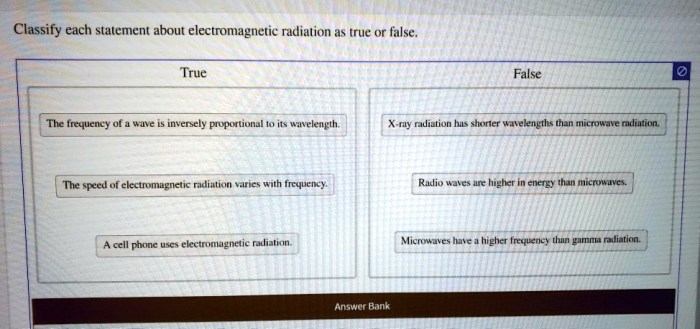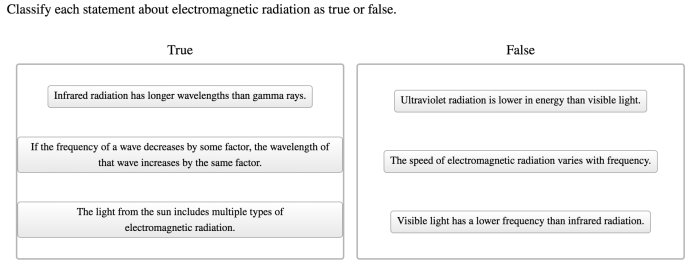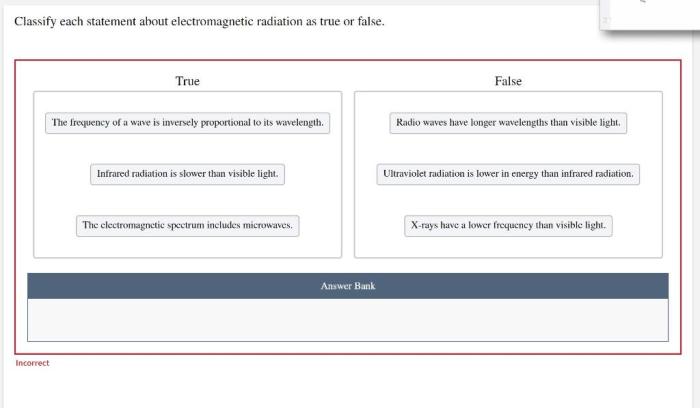Classify each statement about electromagnetic radiation as true or false. – Embark on a journey into the realm of electromagnetic radiation, where we embark on a quest to decipher the truth from the false. Join us as we unravel the mysteries surrounding this enigmatic phenomenon, separating fact from fiction with precision and clarity.
Prepare to be illuminated as we delve into the intricacies of electromagnetic radiation, exploring its diverse applications and unraveling its potential impact on our lives. This comprehensive guide will empower you with the knowledge to navigate the electromagnetic spectrum with confidence, making informed decisions and gaining a deeper understanding of the world around us.
Electromagnetic Radiation

Electromagnetic radiation is a form of energy that travels through space in the form of waves. It is made up of electric and magnetic fields that oscillate perpendicular to each other and to the direction of propagation. Electromagnetic radiation is produced by all objects with a temperature above absolute zero, and it exists over a wide range of wavelengths, from long radio waves to short gamma rays.Electromagnetic
radiation is a fundamental part of our universe. It is responsible for the light we see, the heat we feel, and the radio waves that allow us to communicate. Electromagnetic radiation is also used in a wide variety of technologies, including lasers, radar, and medical imaging.
True or False Statements about Electromagnetic Radiation
| Statement | True/False |
|---|---|
| Electromagnetic radiation is a type of particle. | False |
| Electromagnetic radiation can travel through a vacuum. | True |
| The speed of electromagnetic radiation is the same in all media. | False |
| The wavelength of electromagnetic radiation is inversely proportional to its frequency. | True |
| Electromagnetic radiation can be polarized. | True |
| Electromagnetic radiation is harmful to human health. | False |
| Electromagnetic radiation is used in a wide variety of technologies. | True |
Examples of Electromagnetic Radiation, Classify each statement about electromagnetic radiation as true or false.
Electromagnetic radiation exists over a wide range of wavelengths, from long radio waves to short gamma rays. Some common examples of electromagnetic radiation include:
- Radio waves
- Microwaves
- Infrared radiation
- Visible light
- Ultraviolet radiation
- X-rays
- Gamma rays
Properties of Electromagnetic Radiation
Electromagnetic radiation is characterized by a number of properties, including:
- Wavelength
- Frequency
- Amplitude
- Energy
- Polarization
The wavelength of electromagnetic radiation is the distance between two consecutive crests or troughs of the wave. The frequency of electromagnetic radiation is the number of crests or troughs that pass a given point in one second. The amplitude of electromagnetic radiation is the maximum displacement of the wave from its equilibrium position.
The energy of electromagnetic radiation is proportional to its frequency. The polarization of electromagnetic radiation is the direction of the electric field vector of the wave.
Applications of Electromagnetic Radiation
Electromagnetic radiation is used in a wide variety of applications, including:
- Communication
- Medicine
- Industry
- Research
Electromagnetic radiation is used for communication in a variety of ways, including radio, television, and cell phones. Electromagnetic radiation is also used in medicine for a variety of purposes, including imaging, therapy, and surgery. Electromagnetic radiation is used in industry for a variety of purposes, including heating, welding, and cutting.
Electromagnetic radiation is also used in research for a variety of purposes, including studying the universe and developing new technologies.
Safety Considerations for Electromagnetic Radiation
Electromagnetic radiation can be harmful to human health if it is exposed to high levels of radiation. The most common health effects of electromagnetic radiation are skin burns, eye damage, and cancer. The risk of these health effects depends on the wavelength of the radiation, the intensity of the radiation, and the duration of the exposure.There
are a number of safety guidelines and regulations in place to protect people from exposure to electromagnetic radiation. These guidelines and regulations vary from country to country, but they generally set limits on the amount of electromagnetic radiation that people can be exposed to.
FAQ Compilation: Classify Each Statement About Electromagnetic Radiation As True Or False.
What is electromagnetic radiation?
Electromagnetic radiation is a form of energy that travels through space in the form of waves. It includes a wide range of wavelengths, from long radio waves to short gamma rays.
Is visible light a type of electromagnetic radiation?
Yes, visible light is a type of electromagnetic radiation that falls within the visible spectrum. It has wavelengths ranging from approximately 400 to 700 nanometers.
Can electromagnetic radiation be harmful?
Yes, exposure to high levels of electromagnetic radiation can be harmful to human health. This is particularly true for ionizing radiation, such as X-rays and gamma rays, which can damage cells and DNA.

